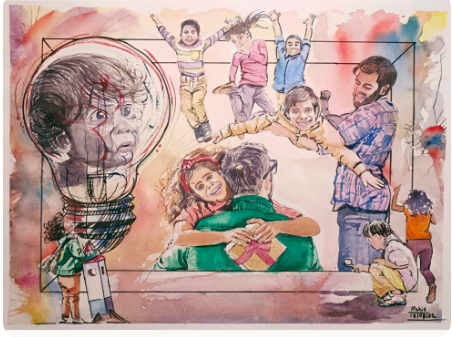Finally! oh! Finally, It was no more a dream. The wait was over! I was to attend my first day as a secondary section student in OFFLINE ( yes! you read it right) mode. It was a long wait and one filled with uncertainties.
Corona ensured that I completed my 5th & 6th stds sitting in front of my tab dealing with the whims & fancies of the ever failing internet connection. The cacophony of online class and my parents’ work meets from home never let me enjoy online school. It was fun for the first few months which later made way for failed attempts to learn and realize how much I missed my friends and offline school.
What a torture it was to communicate with friends via the screen. How I missed the regular mid class talk sessions, sneaking bites of lunch food, throwing paper balls at my friends, asking teachers some genuine as well as sometimes for the sake of it doubts and solving things on the whiteboard. . Corona I hate you !
While the world dealt with bigger problems due to this monster of a disease, I had my own gigantic problems to deal with. Of course no one realized the mental depression I suffered due to the fact that I missed an entire year of being a secondary school student and enjoy its privileges in offline mode. Poor me! Now that the cat is out of the bag, I hope you all realize the problem was indeed graver than what the world faced. I mean seriously, forget kids not able to attend school at all, forget didis & bhaiyas missing their board exams or little ones not knowing why it is mandatory to cry on the first day of school at the school gate. I was deprived of the one thing I looked forward to since my std three. Being a secondary section student.
All my time spent dreaming about how I could now access the hallowed 4th floor corridor where secondary section classes took place, go to the canteen to buy my snacks twice a week and not once, devising new ways to roam the corridors, take part in different school clubs meant only for higher class students just never became a reality. By the way I am very study oriented but what’s fun without mischief and pun. (Ahem ! i hope you get the drift)
Good things come to those who wait,I read somewhere. So I waited day in & day out for the offline school to resume. My prayers were finally answered after two long years. I regretted the fact that I had already missed one precious year of my secondary school. Yet, better late than never. Here I was reading the school reopening circular for the thousandth time and jumping with joy.
I could not understand the worried outlook of my parents on this thing. I was eager to go back to the temple of learning without any demands. What else could make them happy?? I had witnessed them talking with their friends and deliberating on whether to send me to offline school or not. Like seriously! They forgot that I was a girl of principles and discipline. I would never disregard my school instructions. My resolve was solid like a diamond ( the toughest material on earth). I told them so hoping and praying that they did not remember the many occasions when I had tried and failed to miss school for stupid reasons. I am a changed person now. Of course all the motivation came from the single fact that I was now a secondary school student. After neverending discussions with my friends’ parents and coming to know that there would be no online mode of learning they finally agreed.
I was now busy with making all the preparations like school uniforms, picking books from school, covering and labeling them, locating the long forgotten school bag in one of the umpteen drawers and of course making long plans of what and how I would spend my first day at school. I had outlined a few things that I would do with my friends over our google meets. Never had we been so excited for attending school ever! This amused our parents too.
Finally it was the night before my school was to begin. I checked everything –
School bag – done
Uniform – ready
Raincoat (always prepared for mumbai rains) – ready
Water bottle – ready
Tiffin – awaiting to be filled with mom’s delicious food
Self – have been ready for the last 2 years ( hahaha)
I prepared to rest when suddenly a realization jolted me. Now my school timings were for the morning shift ( 7am – 1pm). I attended the primary section in the afternoon shift. I had to now get up at 5.30 am to catch my school bus at 6.30 am. I took some long deep breaths and calmed myself. I told myself that it was no big deal. This was a small hiccup. I just had to develop the habit of getting up early. For the first time I wished I were still in the primary section. It was just a passing thought though. My excitement to be a secondary section student was so much that I could clear every challenge thrown at me for it. Getting up early was nothing!! I set my alarm for 5.30 am. Oh! how I wished the night would just be over and I would be in school.
Did my first day of school really turn out to be the way I had thought it would? Were there any unexpected twists and turns? Well! That is another article away. Would you like to know? Are you all ears( to listen) and eyes ( to read)? I am waiting to know your answer and would love to share. Till then, let me just say “ Be ready for the unexpected”…







